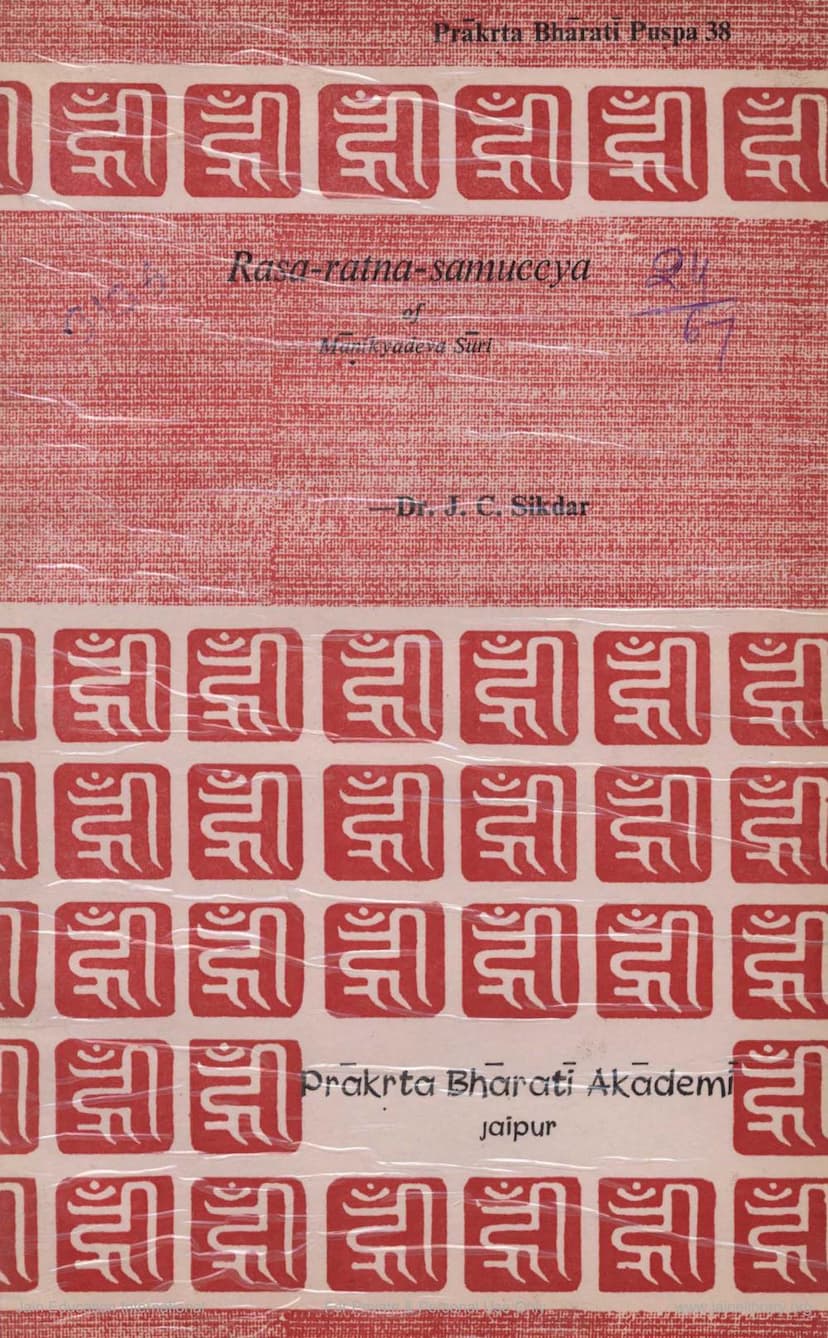Rasratna Samucchay
Added to library: September 2, 2025

Summary
The provided text is an excerpt from "The Rasaratna Samuccaya of Manikyadeva Suri," a Jain text on alchemy and medicine, edited and translated by Dr. J. C. Sikdar and published by Prakrit Bharti Academy in 1986. The excerpt includes a preface, introduction, and portions of the text and translation, detailing the content and historical context of the work.
Here's a comprehensive summary based on the provided pages:
Book Overview:
- Title: The Rasaratna Samuccaya (also referred to as Rasāmṛta Śrī in the translation)
- Author: Manikyadeva Suri
- Publisher: Prakrit Bharti Academy, Jaipur
- Edition: First Edition, December 1986
- Subject: Alchemy and Medicine, with a focus on chemistry and metallurgy.
- Language: Primarily Sanskrit (for the original text).
- Scope: The book deals with various minerals (Mahārasas, Uparasas, Ratnas), metals (Lohas), their chemical preparations, purification processes, the use of mercury, medicinal preparations for various ailments, and alchemical apparatus (Yantras).
Key Information from the Preface and Introduction:
- Jaina Alchemy: The text highlights the significant contribution of Jain scholars to alchemy and medical science in India. It emphasizes that Jaina alchemy has not been fully evaluated within the broader history of Indian alchemy.
- Western India's Role: Gujarat, as a strong center of Jainism, is identified as a hub for alchemical ideas, possibly influenced by both internal Indian traditions and external cultures.
- Dual Trends: The Rasaratna Samuccaya exhibits two distinct trends in alchemy:
- Chemistry and Metallurgy: Focuses on the manipulation and transformation of metals and minerals.
- Medical Science: Explores the use of these substances, particularly mercury, as remedies for various diseases.
- Elixir Vitae: A prominent feature of the work is the search for the "elixir vita," a substance believed to grant immortality or longevity.
- Compilation Nature: Manikyadeva Suri acknowledges his indebtedness to previous Ācāryas and their works, indicating that the Rasaratna Samuccaya is a compilation and epitome based on standard treatises on chemistry, metallurgy, and medicine. It also suggests a possible common Indian source for alchemical knowledge.
- Influence of Other Texts: The work is noted to be based on Indian Ayurvedic texts and Indian chemical treatises. It shows influences and borrows from other known alchemical works like Rasarahasyamahodadhi, Rasārņava, and Rasāvaloka.
- The Author, Manikyadeva Suri:
- Time Period: Believed to have flourished from the second half of the 13th century AD to the first half of the 14th century AD.
- Lineage: A disciple of Sri Devacandra Suri, belonging to the Vațagaccha lineage. This lineage itself has ancient origins, traceable to the 10th century AD.
- Literary Style: Composed in classical Sanskrit with a poetic order, exhibiting rich vocabulary and various metrical patterns (Chandas) such as Āryā-gāthā, Upajati, Vamsastha, Sālini, Vasantatilaka, Anuştubh, Indravajrā, Rathoddhatā, Sragdharā, Skandhaka, Sārdulavikridita, Drutavilambita, and Mandākrāntā.
- Manuscript: The only known manuscript used for this edition is preserved at the L. D. Institute of Indology, Ahmedabad. It is well-preserved and written in Devanagari script.
- Historical and Cultural Significance: The text provides insights into the history of science in India, particularly during the Jatro-chemical period (1300-1550 AD). It offers information on diseases, remedies, diets, social beliefs, economic conditions, educational advancements (evident in the composition and script), and the harmonious coexistence of Brahmanism and Jainism in Gujarat during the author's time.
- Jainistic Invocations: The work begins with a Jainistic salutation to all Siddhas and Rishabhadeva, the first Tirthankara, and ends with a reference to his guru, Sri Devacandra Suri.
- Comparison with Vagbhat: The author seems to have taken the title "Rasaratna Samuccaya" from the work of Vagbhat, another scholar of the Iatro-chemical period, suggesting a connection in their respective periods of intellectual activity.
Content Summary (Chapter-wise):
-
Chapter 1 (Prathama Adhikaraḥ - Rasāṅga Saṁgraha):
- Deals with Mahārasas (superior minerals like mica, copper pyrites), Uparasas (inferior minerals like sulphur, realgar), Ratnas (gems), and Lohas (metals like copper, silver, gold, lead, tin, iron).
- Details various chemical processes for these substances, including purification, "killing" (marana - a process of stabilization or inactivation), and preparation.
- Mentions specific alchemical apparatus like Bhudharayantra and Dolikāyantra.
- Focuses on the purification and "killing" of mercury and other metals and minerals.
-
Chapter 2 (Dvitīya Adhikaraḥ - Rasarahasya):
- Primarily focuses on medical science.
- Discusses the use of mercury and other mineral preparations for treating various diseases such as typhoid, delirium, eczema, anemia, cough, dyspnea, fever, etc.
- The author admits borrowing information from texts like Rasāvaloka, Rasārņava, and Vyādindra-Govindarasa, as well as his own experiences.
- Includes detailed lists of medicinal preparations and their uses.
- Mentions specific medicinal preparations and their constituents, like Rasendra guțikā, Vajrahemarasa, Bhūtabhairavarasa, Brhadvāļavānalarasa, and Cintāmaṇirasa.
- The author states that this chapter is based on Rasarahasyamahodadhi.
-
Chapter 3 (Tṛtīya Adhikaraḥ - Rasāmṛta Śrī):
- References the three guņas of Prakṛti from Samkhya Philosophy and invokes Lord Pārśvanātha.
- Details various medicinal preparations and their specific uses.
- Includes remedies for tuberculosis, cough, dyspnea, cholera, typhoid, fever, anemia with edema, jaundice, and general weakness.
- Mentions specific medicines like Tāmra-Bhairavarasa, Jvarāri rasa, Kapardikarasa, Hiraṇyagarbharasa, Nāgendrarasa, Viśveśvararasa, Agnikumārarasa, and Mahābhairavarasa.
- Discusses treatments for various conditions including chronic dyspepsia, dysentery, stiffness, colic pain, slow fever, paralysis, and poisons.
Overall Significance:
The Rasaratna Samuccaya of Manikyadeva Suri is a significant contribution to the study of ancient Indian alchemy and medicine. It showcases the Jain tradition's engagement with scientific pursuits, particularly in chemistry and pharmacology, demonstrating a sophisticated understanding of minerals, metals, and their therapeutic applications. The work also provides valuable historical and cultural context for the Iatro-chemical period in India.